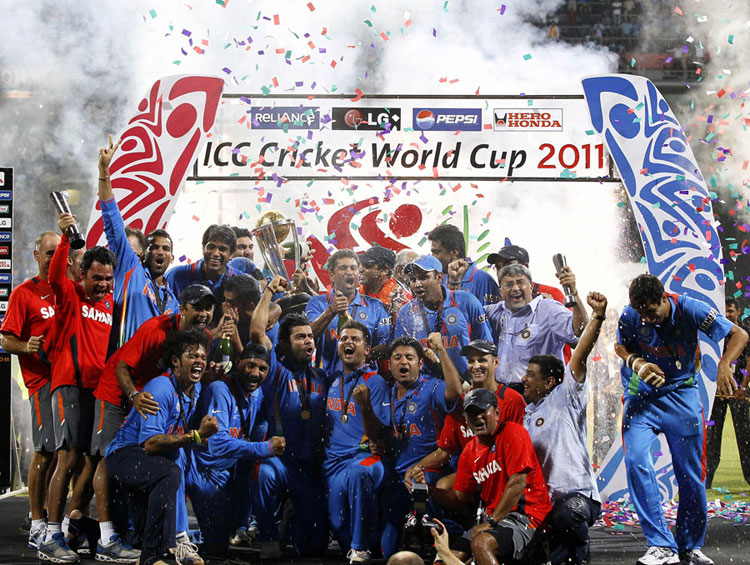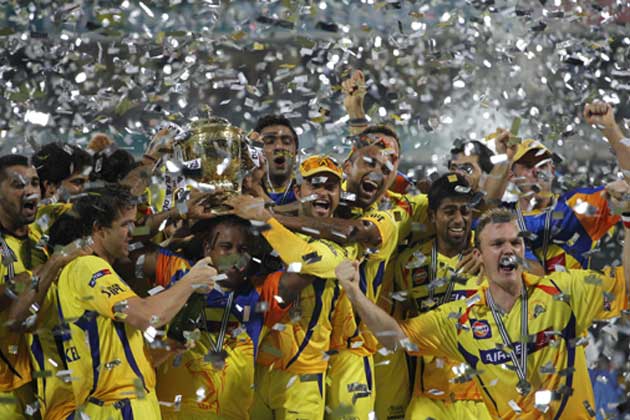|
Tamil Nadu - Sports - Cricket - Types of Cricket Matches & Dissmissal
Ways to Dismiss a batsman
There are ten ways in which a batsman can be dismissed and some are so unusual that only a few instances of them exist in the whole history of the game. The common forms of dismissal are bowled, caught, leg before wicket (lbw), run out, and stumped. The unusual methods are hit wicket, hit the ball twice, obstructed the field, handled the ball and timed out.
Before the umpire will award a dismissal and declare the batsman to be out, a member of the fielding side must appeal. This is invariably done by asking the term Howzat? Which means, simply enough, how is that? If the umpire agrees with the appeal, he will raise a forefinger and say out! Otherwise he will shake his head and say Not out. Appeals are particularly loud when the circumstances of the claimed dismissal are unclear, as is always the case with lbw and often with run outs and stumping.
1. Bowled : The bowler has hit the wicket with the ball and the wicket has "broken" with at least one bail being dislodged (note that if the ball hits the wicket without dislodging a bail it is not out).
2. Caught : The batsman has hit the ball with his bat, or with his hand which was holding the bat, and the ball has been caught before it has touched the ground by a member of the fielding side.
3. Leg before wicket (lbw): First and foremost, the ball must, in the opinion of the on-field umpire, be going on to hit the stumps if the ball had not hit the pad of the batsman first. If the batsman plays an attempted shot to the delivery, then the ball must hit the batsman's pad in line with the stumps and be going on to hit the stumps for the batsman to be given out. If the batsman does not attempt to play a shot, then the ball does not have to hit the pad in line with the stumps but it still must be going on to hit the stumps. If the ball pitches outside the leg stump, then the batsman cannot be given out under any circumstances.
4. Run out : A member of the fielding side has broken or "put down" the wicket with the ball while a batsman was out of his ground; this usually occurs by means of an accurate throw to the wicket while the batsmen are attempting a run.
5. Stumped : It is similar except that it is done by the wicketkeeper after the batsman has missed the bowled ball and has stepped out of his ground, and is not attempting a run.
6. Hit wicket : A batsman is out hit wicket, if he dislodges one or both bails with his bat, person, clothing or equipment in the act of receiving a ball, or in setting off for a run having just received a ball.
7. Hit the ball twice : It is very unusual and was introduced as a safety measure to counter dangerous play and protect the fielders. The batsman may legally play the ball a second time only to stop the ball hitting the wicket after he has already played it.
8. Obstructed the field : Another unusual dismissal which tends to involve a batsman deliberately getting in the way of a fielder.
9. Handled the ball : A batsman must not deliberately touch the ball with his hand, for example to protect his wicket (note that the bowled ball often hits the batsman's hand while it is holding the bat but this is not out; though he can of course be caught off his hand).
10. Timed out : It means that the next batsman did not arrive at the wicket within three minutes of the previous one being dismissed.
In the vast majority of cases, it is the striker who is out when a dismissal occurs. If the non-striker is dismissed it is usually by being run out, but he could also be dismissed for obstructing the field, handling the ball or being timed out. A batsman may leave the field without being dismissed. If injured or taken ill the batsman may temporarily retire, and be replaced by the next batsman. The retiring batsman is not out, and may resume the innings later. An unimpaired batsman may retire, and this is treated as being dismissed Retired out.
Types of Cricket Matches
Test Matches
Test cricket is the highest standard of first-class cricket. A Test match is an international fixture between teams representing those countries that are Full Members of the ICC. It is the longest form of the sport of cricket. Test matches are played between national representative teams with Test status, as determined by the International Cricket Council (ICC), with four innings played between two teams of 11 players over a period of up to a maximum five days. It is generally considered the ultimate test of playing ability and endurance in the sport. The first officially recognized Test match commenced on 15 March 1877, contested by England and Australia at the Melbourne Cricket Ground (MCG).
One day Match
Standard limited over’s cricket was introduced in England in the 1963 season in the form of a knockout cup contested by the first-class county clubs. In 1969, a national league competition was established. The concept was gradually introduced to the other major cricket countries and the first limited over’s international was played in 1971. In 1975, the first Cricket World Cup took place in England. Limited over’s cricket has seen various innovations including the use of multi-colored kit and floodlit matches using a white ball. A one day match, named so because each match is scheduled for completion in a single day, is the common form of limited over’s cricket played on an international level. Each team plays one innings only and faces a limited number of over’s, usually a maximum of 50.
World Cup Championship
The World Cup Tournament will be conducted every Four years once. The first Cricket World Cup contest was organized in England in 1975. A separate Women's Cricket World Cup has been held every four years since 1973.The finals of the Cricket World Cup are contested by all ten Test-playing and ODI-playing nations, together with other nations that qualify through the World Cup Qualifier. Australia has been the most successful of the five teams to have won the tournament, taking four titles. The West Indies and India have won twice, while Pakistan and Sri Lanka have each won once. The 2011 Cricket World Cup tournament was co-hosted by Bangladesh, India, and Sri Lanka with the participation of 14 countries. It is split into two groups within each group; the teams will play in a round-robin format. The top four teams from each group will proceed to the knock out stage playing quarter-finals. Winners of the quarter-finals will play semi-finals and the winning semi-finalists will play in the final.

India won the ICC World Cup title 2011 by defeating Sri Lanka by 6 wickets in the final thus becoming the first team to win a world cup final on home. The next World Cup will be conducted by Australia and New Zealand in 2015.
Twenty 20 Championship
Twenty20 is a new variant of limited over’s itself with the purpose being to complete the match within about three hours, usually in an evening session. The original idea, when the concept was introduced in England in 2003, was to provide workers with an evening entertainment. It was commercially successful and has been adopted internationally. The inaugural Twenty20 World Championship was held in 2007 and won by India. 2009's Twenty20 World Championship was staged in England and won by Pakistan. The next Twenty20 World Championship will be held in the West Indies. 
IPL Champions League
After the inaugural ICC World Twenty20 many domestic Twenty20 leagues were born. First of them was Indian Cricket League which is a rebel league since it is unauthorized by BCCI and led to form an official league called the Indian Premier League. Both these leagues are cash rich and attracted players and audience around the globe. Recently Twenty20 Champions League was formed as a tournament for domestic clubs of various countries.

The Indian Premier League (often abbreviated as IPL) is a professional league for Twenty20 cricket competition in India. It was initiated by the Board of Control for Cricket in India (BCCI) headquartered in Mumbai supervised by BCCI Vice President Chirayu Amin, current chairman and commissioner of IPL, and CEO, Sundar Raman. It is currently contested by 10 teams consisting of players from around the world. It was started after an altercation between the BCCI and the Indian Cricket League. According to global sports salaries review, IPL is the second highest-paid league, based on first-team salaries on a pro rata basis, second only to the NBA. It is estimated that the average salary of an IPL player over a year would be $3.84 million. Rojasthan Royals is the first Championship in 2008; Deccan Chargers in 2009, Chennai Super kings Won the Championship Title for 2010 & 2011.
IPL-4 Champions 2011 CSK

|